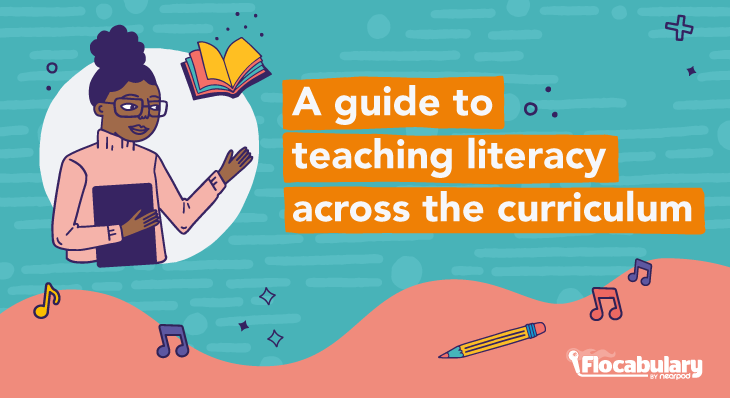
A guide to teaching literacy across the curriculum
What does it mean to teach literacy across the curriculum? How important is teaching literacy in all content areas? As educators, we know that literacy is key to students’ success both in the classroom and beyond. But, how do we build literacy skills? And whose job is it to teach literacy, anyway?
While you might think of literacy as a function of the Language Arts classroom, the truth is reading comprehension plays a key role in every subject area. Processing texts, understanding their meaning, and applying background knowledge in new contexts are all fundamental skills that can be developed and applied in Social Studies, Math, and Science as well as English Language Arts (ELA).
Teachers can help students develop literacy skills by teaching academic vocabulary in every subject—and Flocabulary can help!
Captivate students and make learning experiences memorable and interesting through Flocabulary. Teachers can sign up below to access the activities and lessons shared in this blog post. Administrators can contact us below to learn more about the power of Flocabulary Plus.
What is literacy across the curriculum?
First, let’s start by defining a few key terms.
Literacy has a lot of different definitions, but the goal of literacy across the curriculum is to prepare students with the ability to read, write, speak, and listen in a way that lets them communicate effectively and make sense of the world.
Literacy plays a significant role in reducing educational inequality and prepares students to be thoughtful contributors to school and society. In short, literacy is key for interacting with our world—which is why it’s so important to teach these skills in every subject and classroom.
So let’s dig into a few easy ways you can start teaching academic language in any setting.
A guide to teaching literacy across the curriculum
1. Activate Prior Knowledge & Spark Discussion
We want students to use academic language – words like analyze, summarize, and defend, as well as content-specific language such as median, mode, and hypothesis—but how do we encourage this language in our classrooms? One easy way to increase literacy in any classroom is to use video to introduce a new topic and prompt discussion.
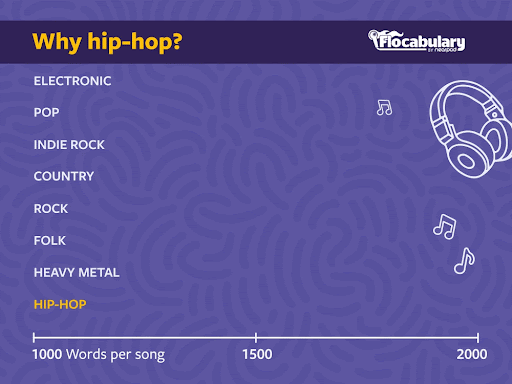
There are plenty of studies on how music and memory go hand in hand. For instance, how did you learn the ABCs? Can you still sing the state capitals? Students are constantly surrounded by music and pop culture, so using music to your advantage in the classroom allows you to familiarize your students with new terms in a memorable, engaging way before really digging into a new concept.
Not only is this a great way to engage your students and get them to speak in academic language, but it’s also a fun way to get students excited about any lesson! Flocabulary videos use hip-hop not only because students love it, but also because the average rap song uses two to three times more words per song than other music genres—packing in even more content in an easy-to-digest way. When a student reads aloud from lyrics or a discussion prompt, it reinforces key vocabulary and boosts confidence in their speaking and comprehension skills. Plus, they’ll be singing the songs for the rest of the day!
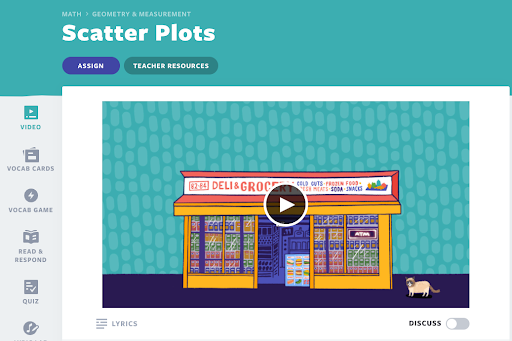
In math class, you could use a video to encourage students to start using academic vocabulary before introducing a new concept. For example, if you’re teaching scatter plots, you could introduce the topic with a Flocabulary video. Using Discuss Mode, students begin using vocabulary like “outlier” and “variables” in a class discussion before practicing on their own.
Need more literacy resources for your content area? The 2025 What Kids Are Reading report provides subject-specific text recommendations based on data from millions of students.
2. Build on Informational Texts
Informational texts are everywhere! They can be found in almost every subject area and classroom, and there’s a reason why! Reading and analyzing informational texts equips students with the skills to be successful in college, career, and future learning. Because they can be found in almost every classroom, this is a great place to teach literacy skills across the curriculum! Additionally, integrating the Science of Reading into your instruction is essential.
By pairing your informational text with a video, you can pre-teach tier 2 and tier 3 vocabulary and prepare students to break down what they’re reading. Research shows that vocabulary is an especially strong predictor of informational text comprehension. By exposing your students to this vocabulary before they read a complex text, you can increase overall comprehension! Plus, if you have struggling readers, you can assign practice activities like Flocabulary’s Vocab Cards or Read & Respond to provide scaffolded support and teach academic language and create a literacy rich environment.
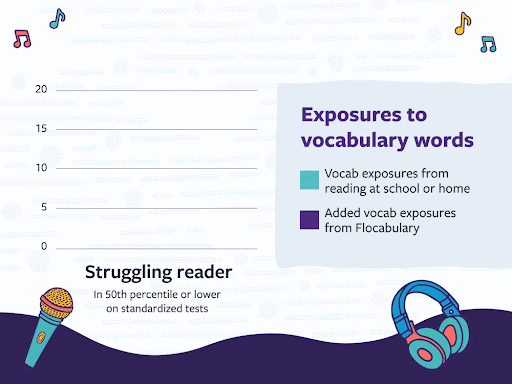
Flocabulary teaches students essential skills that enhance reading literacy and learning, making it easier for them to understand complex texts in different content areas. Through interactive activities, students write about what they’ve learned, reinforcing their comprehension and improving their ability to express ideas across multiple subjects. For example, take a lesson on Ancient Egypt for middle and high school. You can use a kid-approved Flocabulary video to preview the topic and build vocabulary before students dig into informational texts to improve comprehension. You can even differentiate for students’ diverse needs by providing opportunities for further practice with Vocab Cards or a practice Quiz. Consider using the vocabulary words in the Flocabulary lessons to create word walls in your classroom library and practice them when it’s time to read.

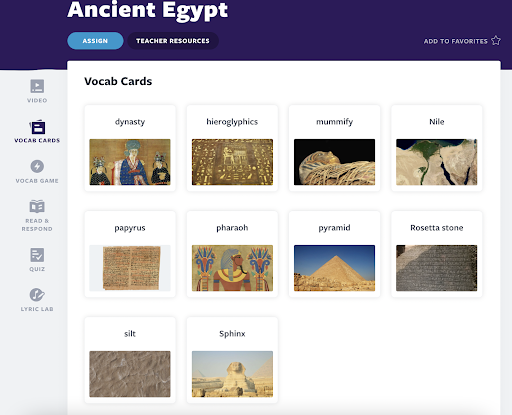

3. Ditch the text and try video!
Another great way to integrate literacy and learning across the curriculum is to use video instead of a long reading passage. Did you know that video viewers retain 95% of a video’s message compared to 10% when reading a text? Not only do students retain more information from a video than reading, but it’s also a fun way to ignite interest in a new topic!
Using video in the classroom boosts retention and sets students up for success before they even begin a new area of study. Even more, you can easily differentiate for individual students’ needs by assigning practice activities, adjusting video playback speed, or turning on Immersive Reader and closed caption functionality—allowing every student to succeed! If you want your students to practice written literacy development, assign a Read & Respond to provide further vocabulary practice for struggling or advanced readers.
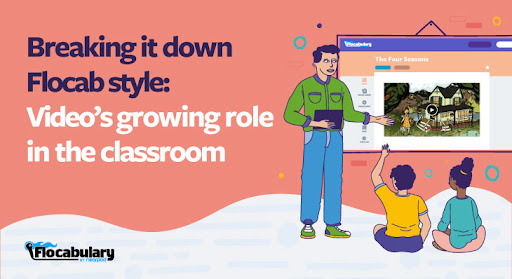
As a former Language Arts teacher and avid reader myself, I’m NOT saying to throw out all your favorite books… but video can be a great way to encourage retention of new information when the goal of a lesson is to build new vocabulary or practice a new skill.
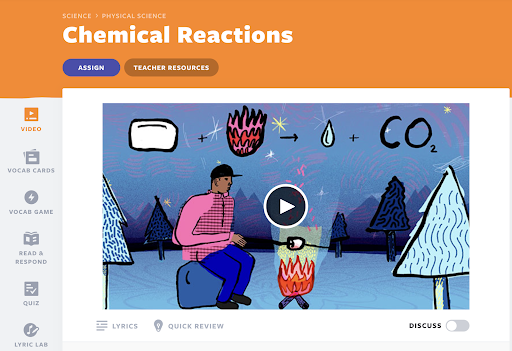
Let’s say you’re pre-teaching students about Chemical Reactions in your science class to implement literacy across content areas. Instead of assigning a long passage on chemical reactions before a lab, you can introduce vocabulary and practice with a video to build the academic vocabulary students need to become scientists in the experiment.
Start teaching literacy across the curriculum
As educators, we want our students to not only succeed in our own classrooms but throughout their educational experiences and beyond. Literacy instruction plays a pivotal role in this success. Think of how often you use your own reading and comprehension skills in everyday life!
Flocabulary supports content area reading literacy strategies by incorporating engaging multimedia lessons that connect to various subjects. Making literacy a goal of every class allows students to practice and build the skills that will support students as they navigate the 21st-century world. By supporting struggling readers to think, read, and write critically, teachers can prepare students to be meaningful contributors to society.
It may seem overwhelming at first, but start small! Add a few minutes of vocabulary instruction at the beginning of your next lesson, and build from there. You’ve got this!
Captivate students and make learning experiences memorable and interesting through Flocabulary. Teachers can sign up below to access the activities and lessons shared in this blog post. Administrators can contact us below to learn more about the power of Flocabulary Plus.
